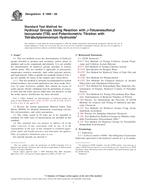We need your consent to use the individual data so that you can see information about your interests, among other things. Click "OK" to give your consent.
ASTM E1899-08
Standard Test Method for Hydroxyl Groups Using Reaction with p-Toluenesulfonyl Isocyanate (TSI) and Potentiometric Titration with Tetrabutylammonium Hydroxide
STANDARD published on 1.4.2008
The information about the standard:
Designation standards: ASTM E1899-08
Note: WITHDRAWN
Publication date standards: 1.4.2008
SKU: NS-43499
The number of pages: 5
Approximate weight : 15 g (0.03 lbs)
Country: American technical standard
Category: Technical standards ASTM
The category - similar standards:
Annotation of standard text ASTM E1899-08 :
Keywords:
hydroxyl number, p-Toluenesulfonyl isocyanate, polyacetals, polyols, potentiometric titration, tetrabutylammonium hydroxide, Hydroxyl groups, Potentiometric titration, Tetrabutylammonium hydroxide, p-Toluenesulfonyl isocyanate (TSI), ICS Number Code 71.040.40 (Chemical analysis)
Additional information
| Significance and Use | ||||||||||||||||||||||||||
|
Hydroxyl is an important functional group and knowledge of its content is required in many intermediate and end use applications. This test method is for the determination of primary and secondary hydroxyl groups and can be used for the assay of compounds containing them. This test method has the following advantages over other hydroxyl number methods: It is rapid (10 min), pyridine-free, ambient temperature, small sample size, applicable to extremely low hydroxyl numbers (<1), and is amenable to automation. |
||||||||||||||||||||||||||
| 1. Scope | ||||||||||||||||||||||||||
|
1.1 This test method covers the determination of hydroxyl groups attached to primary and secondary carbon atoms in aliphatic and cyclic compounds and phenols. It is not suitable for determination of hydroxyl groups attached to tertiary carbon atoms. This test method is applicable to polyacetals, temperature sensitive materials, high solids polymer polyols, and rigid polyols. Other available test methods listed in Note 1 are not suitable for many of the sample types listed above. 1.1.1 This test method is currently recommended for neutral refined products. Successful application has been made, however, to some in-process samples that contain an excess of acidic species. Proper validation must be performed, of course, to show that the acidic species either does not interfere, or that the acidic species interference has been obviated. Note 1—Other methods for determination of hydroxyl groups are given in Test Methods D 817, D 871, D 1957, D 2195, D 4252, D 4273, D 4274, E 222, E 326, and E 335. 1.2 Review the current appropriate Material Safety Data Sheets (MSDS) for detailed information concerning toxicity, first aid procedures, and safety precautions. 1.3 The values stated in SI units are to be regarded as standard. No other units of measurement are included in this standard. 1.4 This standard does not purport to address all of the safety concerns, if any, associated, with its use. It is the responsibility of the user of this standard to establish appropriate safety and health practices and determine the applicability of regulatory limitations prior to use. For specific hazards see Section 9. |
||||||||||||||||||||||||||
| 2. Referenced Documents | ||||||||||||||||||||||||||
|
Similar standards:
Historical
1.5.2014
Historical
15.6.2012
Historical
1.3.2008
Historical
1.10.2013
Historical
1.6.2010
Historical
1.12.2012
We recommend:
Technical standards updating
Do you want to make sure you use only the valid technical standards?
We can offer you a solution which will provide you a monthly overview concerning the updating of standards which you use.
Would you like to know more? Look at this page.



 ASTM D6656-14a
ASTM D6656-14a ASTM D6808-02(2012)..
ASTM D6808-02(2012).. ASTM D6827-02(2008)..
ASTM D6827-02(2008).. ASTM D6839-13
ASTM D6839-13 ASTM D6843-10
ASTM D6843-10 ASTM D6854-12a
ASTM D6854-12a
 Cookies
Cookies
